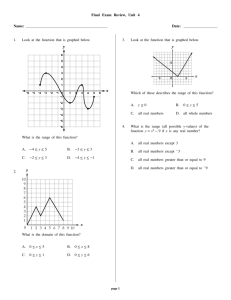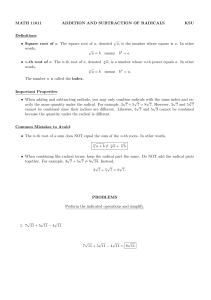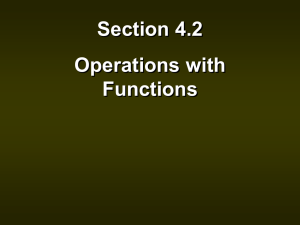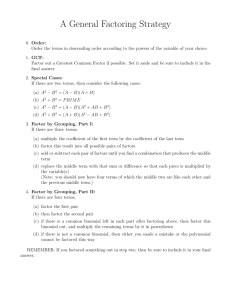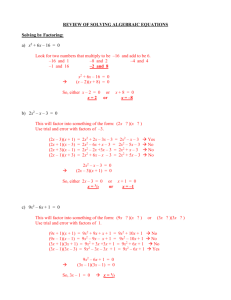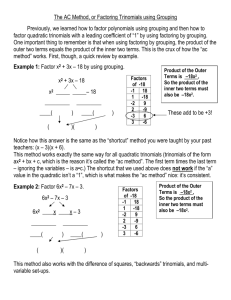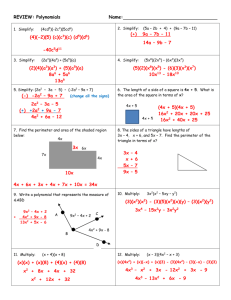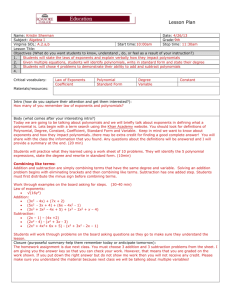Polynomial division
advertisement
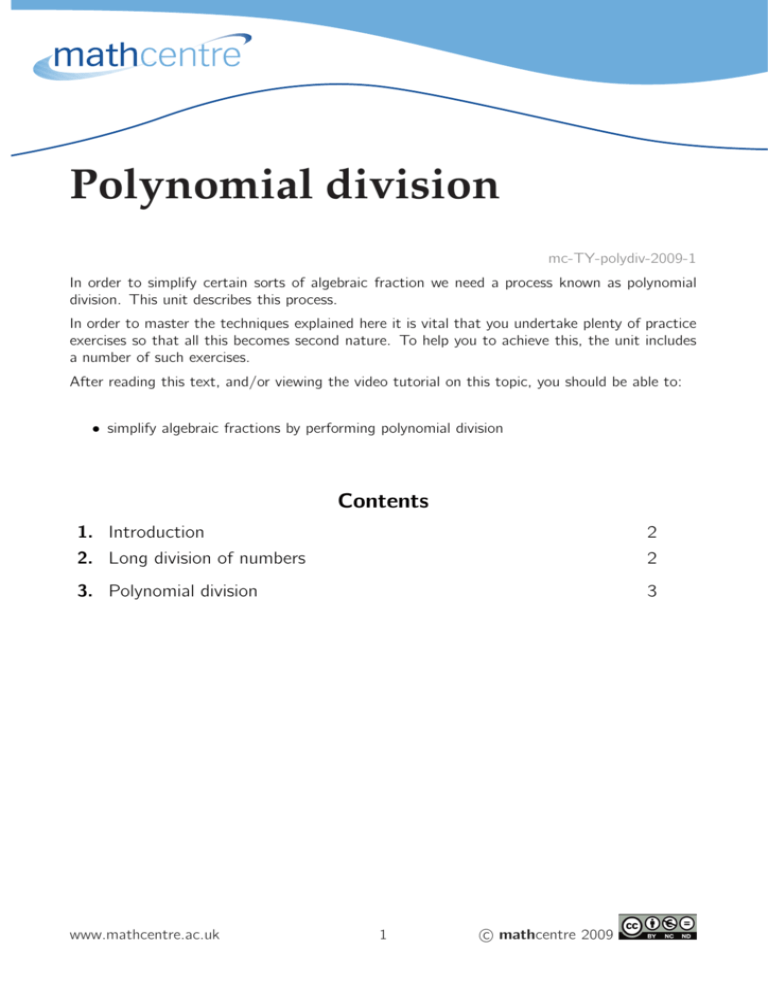
Polynomial division mc-TY-polydiv-2009-1 In order to simplify certain sorts of algebraic fraction we need a process known as polynomial division. This unit describes this process. In order to master the techniques explained here it is vital that you undertake plenty of practice exercises so that all this becomes second nature. To help you to achieve this, the unit includes a number of such exercises. After reading this text, and/or viewing the video tutorial on this topic, you should be able to: • simplify algebraic fractions by performing polynomial division Contents 1. Introduction 2 2. Long division of numbers 2 3. Polynomial division 3 www.mathcentre.ac.uk 1 c mathcentre 2009 1. Introduction In order to simplify certain sorts of algebraic fraction we need a process known as polynomial division. This unit describes how this process is carried out. 2. Long Division of numbers The process is very like the long division of numbers. Let us look in detail at a long division sum and try to see how the process works. You should work through the example yourself since we are going to examine exactly how it was done. Example Suppose we wish to divide 2675 by 25. The calculation is set out like this: 107 25 2675 25 175 175 0 Now how was it done ? The first question was ‘how many times does 25 divide into 26 ?’. The answer is 1 and this is recorded above the 6. We then multiplied the 25 by 1 and wrote the answer down beneath the 26. This is so that by subtracting the answer from 26 we can find out how much is left over after the division of 26 by 25. The amount left over, or remainder, is 1. Given its position the one remainder is not 1 unit but 1 hundred. We now bring down the next figure in 2675, the 7, and set it alongside the 1 to give 17. The question we ask now is ‘how many times does 25 divide into 17 ?’. The answer is none, which we record with 0 above the 7. We now bring down the next figure in 2675, the 5, and set it alongside the 17 to give 175. The question we ask now is ‘how many times does 25 divide into 175 ?’. We guess the answer is 7, which we record above the 5 of 2675. This guess is important for what follows in polynomial division. We could base the guess on a rough estimate, how many times does 2 divide into 17, and the answer is 8. However 8 multiplied by 25 is 200, way over 175. Thus we go with 7. We now multiply 25 by 7 to get 175 and write this below the 175 already there. We are seeking to find out how much is left over, or the remainder after the division has been completed, and so we subtract 175 from 175 giving an answer of 0, i.e. there is no remainder and the division is finished. 2675 = 107. We see that 25 divides into 2675 exactly, 107 times, with no remainder, that is 25 www.mathcentre.ac.uk 2 c mathcentre 2009 3. Polynomial division We now do the same process with algebra. Example Suppose we wish to find 27x3 + 9x2 − 3x − 10 3x − 2 The calculation is set out as we did before for long division of numbers: 3x − 2 27x3 + 9x2 − 3x − 10 The question we ask is ‘how many times does 3x, NOT 3x − 2, go into 27x3 ?’. The answer is 9x2 times. And we record this above the x2 place, just as we did with the numbers: 9x2 3x − 2 27x3 + 9x2 − 3x − 10 Just as we did with the numbers we need to find the remainder, and so we multiply 9x2 by 3x − 2 and write the answer down under 27x3 + 9x2 . Thus we get: 9x2 3x − 2 27x3 + 9x2 − 3x − 10 27x3 − 18x2 To find out what is left we now subtract, and get 27x2 , and as with the numbers we now bring down the next term, the −3x, and write it alongside the 27x2 to give: 9x2 3x − 2 27x3 + 9x2 − 3x − 10 27x3 − 18x2 27x2 − 3x The question to be asked now is, ‘how many times does 3x, NOT 3x − 2, go into 27x2 ?’. The answer is 9x and we write this above the −3x term, i.e. above the x place: 9x2 + 9x 3x − 2 27x3 + 9x2 − 3x − 10 27x3 − 18x2 27x2 − 3x Again we want to know what is left over from the division, so we multiply 3x − 2 by the 9x and write the answer down so we can subtract it from 27x2 − 3x, giving us 15x: 9x2 + 9x 3x − 2 27x3 + 9x2 − 3x − 10 27x3 − 18x2 27x2 − 3x 27x2 − 18x 15x The process is now repeated for the third time; bring down the next term, −10, write it next to the 15x, and ask ‘how many times does 3x, not 3x − 2, go into 15x ?’. www.mathcentre.ac.uk 3 c mathcentre 2009 9x2 + 9x 3x − 2 27x3 + 9x2 − 3x − 10 27x3 − 18x2 27x2 − 3x 27x2 − 18x 15x − 10 3x divides into 15x five times, and so we record this above the number place, above the 10. We multiply 3x − 2 by 5 and write the answer down so we can subtract it from 15x − 10 and see what the remainder is: 9x2 + 9x + 5 3x − 2 27x3 + 9x2 − 3x − 10 27x3 − 18x2 27x2 − 3x 27x2 − 18x 15x − 10 15x − 10 0 And in this case there is no remainder. Thus 27x3 + 9x2 − 3x − 10 = 9x2 + 9x + 5 3x − 2 Check back through the calculation again and compare it with 2675 divided by 25. You should see that effectively they are the same process. Example Suppose we wish to find x4 + x3 + 7x2 − 6x + 8 x2 + 2x + 8 The calculation is set out as follows, and an explanation is given below. x2 − x + 1 x + 2x + 8 x + x + 7x2 − 6x + 8 x4 + 2x3 + 8x2 − x3 − x2 − 6x − x3 − 2x2 − 8x x2 + 2x + 8 x2 + 2x + 8 0 2 4 3 Work through the example. Your thinking should be moving along the lines: ‘How many times does x2 go into x4 ?’. The answer is x2 times. Write x2 above the x2 place in x4 + x3 + 7x2 − 6x + 8. Multiply x2 + 2x + 8 by x2 , write the answer down underneath x4 + x3 + 7x2 and subtract to find the remainder - which is −x3 − x2 . Bring down the next term, −6x, to give −x3 − x2 − 6x. ‘How many times does x2 go into −x3 ?’. The answer is −x times. Write −x above the x place in x4 + x3 + 7x2 − 6x + 8 www.mathcentre.ac.uk 4 c mathcentre 2009 Multiply x2 + 2x + 8 by −x, write the answer underneath −x3 − x2 − 6x and subtract to find the remainder, which is x2 + 2x. Bring down the next term, 8, to give x2 + 2x + 8. ‘How many times does x2 go into x2 ?’ The answer is 1. Write 1 above the number place in x4 + x3 + 7x2 − 6x + 8. Multiply x2 + 2x + 8 by 1, write the answer down underneath x2 + 2x + 8 and subtract to find the remainder, which is 0. So we conclude that x4 + x3 + 7x2 − 6x + 8 = x2 − x + 1 x2 + 2x + 8 Example What happens if some of the terms are missing from the polynomial into which we are dividing? The answer is that we leave space for them when we set out the division and write in the answers to the various small divisions that we do in the places where they would normally go. Suppose we wish to find x3 − 1 x−1 The calculation is set out as follows: x2 + x + 1 x − 1 x3 −1 x3 − x2 x2 x2 − x x−1 x−1 0 We conclude that x3 − 1 = x2 + x + 1 x−1 Example What would we do if there was a final remainder, something other than 0 ? For example, suppose we needed to find 27x3 + 9x2 − 3x − 9 3x − 2 We do exactly the same: 9x2 + 9x + 5 3 3x − 2 27x + 9x2 − 3x − 9 27x3 − 18x2 27x2 − 3x 27x2 − 18x 15x − 9 15x − 10 1 www.mathcentre.ac.uk 5 c mathcentre 2009 We now have a remainder of 1, which still has to be divided by 3x − 2. Thus our final answer now is: 1 27x3 + 9x2 − 3x − 9 = 9x2 + 9x + 5 + 3x − 2 3x − 2 Exercises Use polynomal division to simplify each of the following quotients. a) d) g) x4 + 3x3 − x2 − x + 6 x+3 4 2x + 8x3 − 5x2 − 4x + 2 x2 + 4x − 2 x3 − 2x2 − 4 x−2 Answers a) x3 − x + 2 b) e) h) 2x4 − 5x3 + 2x2 + 5x − 10 x−2 4 3 3x − x + 8x2 + 5x + 3 x2 − x + 3 x3 − 4x2 + 9 x−3 b) 2x3 − x2 + 5 c) 7x3 − 3x2 + 3 e) 3x2 + 2x + 1 f) x2 + 3x − 1 x2 − x − 3 i) x2 + x + 7 d) 2x2 − 1 g) x2 + 2x + 2 h) www.mathcentre.ac.uk 6 c) f) i) 7x4 − 10x3 + 3x2 + 3x − 3 x−1 4 3 3x + 9x − 5x2 − 6x + 2 3x2 − 2 x4 − 13x − 42 x2 − x − 6 c mathcentre 2009
